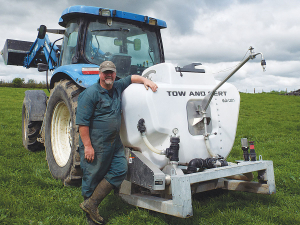New dimension in fert application
With new nitrogen fertiliser restrictions due to kick in during July 2021, with a target to apply less than 190 units N/ha, many farmers will be having a re-think on fertiliser application.
 Matamata farmer Matthew Zonderop says he’s never looked back since he started using a Tow and Fert unit about three years ago.
Matamata farmer Matthew Zonderop says he’s never looked back since he started using a Tow and Fert unit about three years ago.
Matamata farmer Matthew Zonderop says he’s never looked back since he started using a Tow and Fert unit about three years ago.
Zonderop farms 140ha in a 50:50 partnership at Te Poi, near Matamata, running a herd of 420 cross-bred dairy cows.
Having previously used conventional fertiliser, Zonderop saw a friend using the Tow and Fert system with success and decided to take the plunge.
In essence the unit is a heavy-duty spraying rig, with an integral mixing and agitation component.
Zonderop’s Multi 1200 linkage mounted machine comprises a 1200L moulded tank carried in a heavy-duty galvanised frame, pipework with extensive use of stainless steel and attachment via snap-lok fittings.
The design offers the ability to dissolve and mix urea, lime, gibberellic acid, weed sprays, trace elements, humates and seeds – using dairy effluent or water as the medium for application.
Manufacturer Metalform says foliar application of nutrients leads to quicker uptake, reduced losses to the atmosphere and leaching.
An added benefit of this spraying rig is that it is able to combine several products in a single mix to help reduce labour and operating costs.
Zonderop runs a grass-based system that typically sees paddocks being grown to 2900 to 3100 kgDM/ha prior and 1500kgDM post-grazing.
The sprayer moves onto the paddocks about five days after grazing to apply sulphate of ammonia, Pro-Gib and,
if required, Baton herbicide.
“Application is very uniform and up to 10m width depending on wind conditions,” he says.
“Interestingly, paddocks show a noticeable response within 4 or 5 days – probably 2 or 3 times quicker than conventional methods.”
The process sees 500kg of fertiliser dissolved and carried in 900L of water, a process that takes about 15 minutes, with agitation/circulation continuing as the unit moves to a job. Zonderop believes the rapid uptake of nutrients by plants allows him to reduce application rates, saving about 25% over conventional application methods.
Operation is said to be easy with a in-built weigh system, a distinct lack of electronics and the only real choice being nozzle selection to alter application rates.
Beyond the fertiliser application, the machine is also used to apply magnesium sulphate in spring, as a blanket coverage said to last for up to 90 days before grazing. This saves the daily chore of application by ATV and spreader.
The same principle is also used for the application of zinc sulphate for facial eczema prevention, although a half dose is still used in the water supply as an insurance policy.
The rig can also apply chicory seed in suspension, with the occasional application of grass seeds in rougher areas.
Interestingly, last season saw an extended dry period when crops of turnips or chicory were being established, so the Multi 1200 was brought into action for irrigation, applying effluent diluted 50:50 with water. Zonderop concedes this was a time-consuming job but it broke the drought.
Mating wrapped up last month at the across-breed Beef Progeny Test on Pāmu’s Kepler Farm in Manapouri.
Libby Judson is a keeper of memories from an age gone by. Tim Fulton tells her story.
A New Zealand-first native tree study has highlighted the Bioeconomy Science Institute's position as a forestry research leader.
Hemp fibre processor Rubisco is relocating its core processing facility to Ashburton as part of a $20-$30 million expansion to leverage what it says is an accelerating global demand for sustainable and renewable fibres.
Tradition meets some of the latest in technology at the 2026 East Coast Farming Expo.
OPINION: Trade Minister Todd McClay and the trade negotiator in government have presented Kiwis with an amazing gift for 2026 - a long awaited and critical free trade deal with India.

OPINION: If the hand-wringing, cravat and bow-tie wearing commentariat of a left-leaning persuasion had any influence on global markets, we'd…
OPINION: With Winston Peters playing politics with the PM's Indian FTA, all eyes will be on Labour who have the…